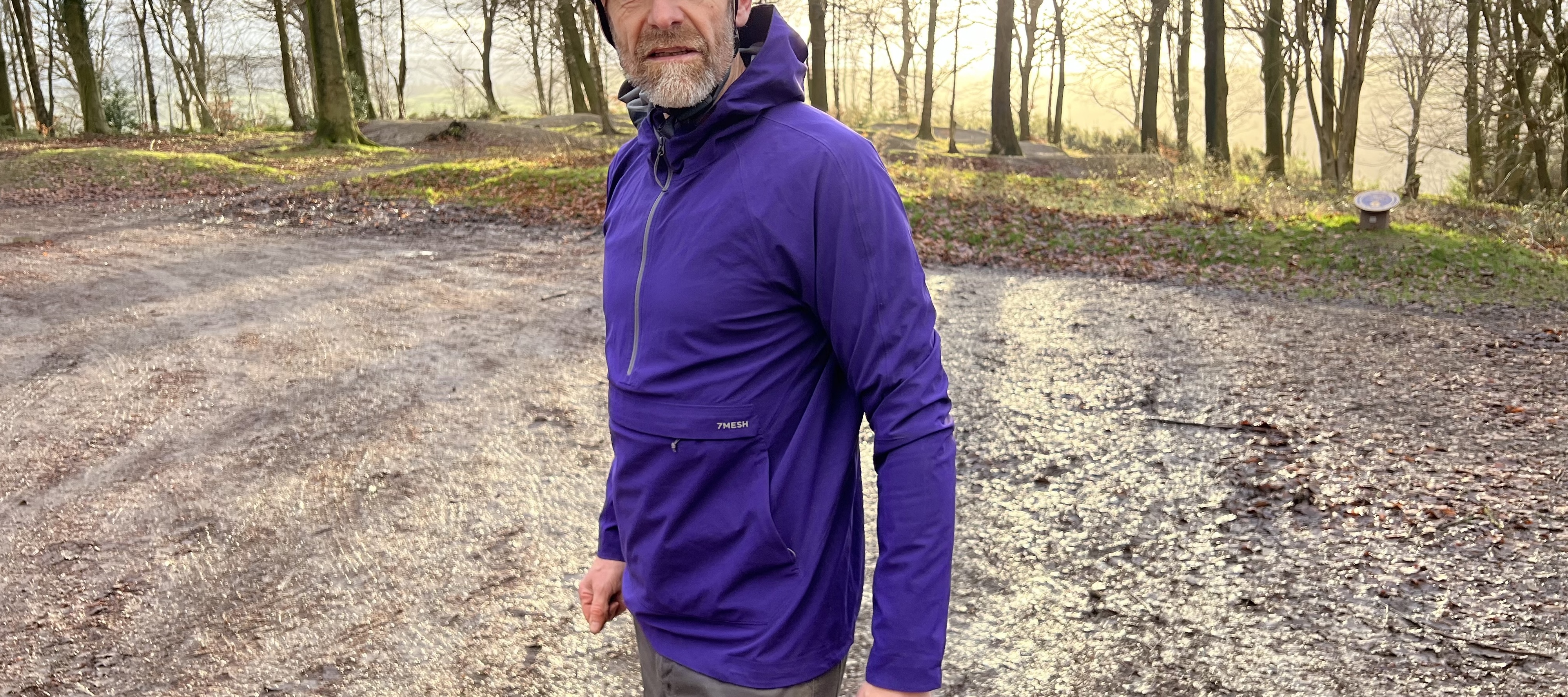Bike Perfect Verdict
Beautifully constructed and low eco impact smock that’s breezier and more breathable than a pure hardshell. The price will definitely make most people sweat compared to lighter, more stowable windshells that give a comparable overall effect at a fraction of the cost.
Pros
- +
More breathable and cooler than most high performance hardshell
- +
Soft feel fabric with slight stretch for quiet comfort
- +
Packs into it’s own bag with built in bar/frame/bag straps
- +
Versatile casual smock or conventional jacket options
- +
Impeccable eco credentials and reduced price repair
Cons
- -
Very expensive
- -
Not fully water proof but still sweaty at higher effort levels
- -
Wind permeability makes it cold on extended descents
- -
You can’t put much in the kangaroo pouch without it getting in the way
- -
Elaborate cut is wasted on the casual baggy fit
Why trust BikePerfect
Everyone I know who has a 7mesh Chilco WTV Anorak lives in it, so I had very high hopes for the new Cache Anorak and it’s exclusive AirMap fabric. It’s certainly got plenty of the Canadian brand’s typically premium detailing and innovative thinking, but after searching for the AirMap sweet spot for months I still haven’t found it.
Design and build
The Cache actually follows a very similar style pattern to the Chilco, with a kangaroo front pocket with zips either end. A tall soft front lined collar extends into a cord adjustable hood that works under or over a helmet. Turning the Cache inside out reveals a complex Tetris style patchwork of slim seam taped pieces. These include lighter two-layer fabric ‘wings’ on sides and shoulder backs, while the rest of the jacket apart from cuffs and hem are three-layer. The 83 percent polyester, 17 percent spandex face fabric is slightly stretchy to add extra mobility too. Both the stretch and the panelling seem overkill though as even in a size small it was still a casual boxy fit overall. The arms are simple tubes but generous length and half cuff elastication means my wrists were well covered – despite arms that normally make medium jacket sleeves look short. It comes in a wide range of sizes from XS to XXL as well as women’s cuts so most riders should be able to find a good fit in a Cache.
A separate ‘stash pocket’ with a top entry zip sits behind the marsupial pocket. The whole jacket can be reversed into this and strapped onto bars, frame or bags with the hook together elasticated straps at each corner but it’s still relatively bulky.
The face fabric is 83 percent recycled while the backer is 100 percent recycled, all fabrics are Membrane: 100 percent polyurethane Bluesign approved and Oeko-Tex Standard 100 certified. 7mesh also offer discretionary repair if you accidentally trash your jacket within 30 days of buying it, or discounted repairs beyond that.

Performance
As I said at the start I absolutely love the WTV wind management fleece tech introduced by 7mesh last year. Everyone I know who’s got WTV gear rarely wears anything else once the weather gets nasty. Apart from some pocket placement glitches I’ve never tested a piece of clothing from the Canadian firm that hasn’t been brilliant and I still regularly wear the first shirt and shorts they sent me.
Forgive me then for maybe being overly excited about the new AirMap. Particularly as it works on the same basic principle of letting wind ebb and flow through the fabric to help manage heat and sweat levels.
Testing started off reasonably promising with seven hours on the bike as part of the sweeper team at the back of the legendarily grueling 3 Peaks Cyclo Cross race. It was typically meh weather for the Yorkshire Dales event in September too, warm in theory (around ten degrees C) but with fairly relentless rain and drizzle taking the effective temperature down dramatically. Shepherding the slowest riders is a real stop/start business and the course alternates high energy pedals or hike a bikes up stupid steep slopes with rattling down super tech or super fast descents. Apart from a couple of long descents when the wind I could feel coming through the fabric which dropped my temperature enough to make me put the hood up, the Cache was good. I didn’t have to really do much with the zip on the climbs or the descents and while I was definitely damp, I was comfortable. Then again, so were the folks I was riding with and they were wearing everything from hardshell to soft-shell and even long sleeve thermal jerseys.
It’s been the same story for the past three months on most rides. Cold, mild, cold and drizzly, cold and wet, mild and wet, snowy, windy, etc. But mostly the mixed intermediate conditions that 7mesh are saying that AirMap should work extremely well in. And don’t get me wrong, the wind circulation means it’s been lovely and dry inside when cruising. But even on the dry, freezing cold days where there’s enough temperature differential to really help fabric vent and enough windflow to help dissipate the vapor and lower body temp, it’ll still get damp inside once you start working hard.

Even after multiple specified re-washes to cure a potential manufacturing issue with the waterproofing, it still didn’t do a ton to keep rain out either, particularly if it got heavy. And while it did dry faster than a pure hardshell because of the wind I could feel flowing through it at speed, that also meant it was frequently uncomfortably cool to the point where I wondered why I was bothering to wear a jacket at all. Especially one that cost over $300 / £300 and weighs nearly 300g even in a small.
While it doesn’t billow or flap like you might expect, I still found the non stowable hood a bit flappy and obvious behind my head at times. There’s only so much you can put in the kangaroo pocket before it gets in the way of pedaling. It would definitely be easier to vent effectively rather than just inflate with a full length zip too. Thankfully there’s a jacket version of the Cache if you want a full front zip, with hand pockets but not a hood if you prefer conventional not fashionably retro.
On the plus side, that handy eat itself pocket means you can stow it really quickly with the attached straps if you get damp when you’re working hard. The fabric is quiet, natural feeling and doesn’t feel clammy on bare skin if you’re short sleeving underneath. Details like the minimal area of seam sealing means it’s better than most hardshells in terms of sweat management, so if you’re cruising rather than pushing on. In other words, while it’s not truly waterproof externally, you’ll generally be drier for more of the time than if you were wearing a shell that was – and that is to be fair the whole point of the AirMap approach.

Verdict
I’ve invested a ridiculous amount of time – and a good chunk of my already questionable sanity – riding this jacket in as many conditions as possible and comparing it directly against it’s peers in the process. I’m confident I’ve put it through all the situations it could shine in and I’ve been comparing notes with other veteran testers who are working with AirMap at the moment. So after all that, here’s where I’m at.
The Cache is very comfortable, unrestrictive and the high level of air flow through the fabric means it breathes a lot better than most hard shells. As a result, it’s impressively dry inside on casual rides. The storable pouch / pack is a neat idea and it scores very high in terms of eco credentials and customer support.
However, the bottom line is that the obvious windflow also equates to obvious windchill. So while you might be drier when riding, you’re rarely warmer than you would be if you were damp but better wind protected. Seeing as your body can only sense rate of temperature loss rather than whether it’s wet or dry, the breathability only really boosts warmth when you stop or get out of the wind. But then it doesn’t really do much to protect from rain either, so in heavy showers or more you’ll be wet anyway.
And if this is all getting a bit of a mind melt, what that means is while the methodology and specifics are different, overall protection levels are only comparable to much lighter, more packable windshells at a third to half of the price.
Plus compared to it’s smart fleece 7mesh stablemate, the Chilco Anorak, which somehow manages to be the perfect temperature inside whatever heinous climate you’re riding through, the Cache has consistently been colder than I’ve wanted. And don’t come at me with ‘well put a warmer layer on underneath then’, because when you do that you lose the better wicking/breathability element because of the thicker base. So you end up bundling it up in it’s pouch and wondering why you bought it again, because you’re not noticeably colder without it. If you’re determined to drop this much cash on element managing clothing then go for Polartec Neoshell or Polartec Alpha jackets which perform noticeably better either side of the waterproof / weather management performance bias.
But then, while I’m disappointed – because I think it’s fantastic when small companies like 7mesh push super hard with innovation and it’s the first time I’ve not loved a piece of their kit – I’m not surprised. Because the eco-elephant in the room here is that while they’re great in terms of removing some essentially everlasting toxic chemicals from environment. Unfortunately the new non-PFC DWR (Durable Water Repellent) alternatives just aren’t as good as doing the water repellency thing and they’re definitely not as good at the durability thing. In short, most things that are trending towards ‘waterproof’ that I’m testing right now are disappointing compared to previous generation gear.
So while I’ll keep trying every new jacket I can in the hope of better news, the best ‘sustainable’ performance choice you can probably make right now is hanging onto the old jacket you already have.
Tech specs: 7mesh Cache Anorak
- Price: $330, £330, €330
- Sizes: XS to XXL
- Colors: Prince (tested) Butterscotch, Black
- Weight: 290g (small tested)

Guy Kesteven has been working on Bike Perfect since its launch in 2019. He started writing and testing for bike mags in 1996. Since then he’s written several million words about several thousand test bikes and a ridiculous amount of riding gear. He’s also penned a handful of bike-related books and he reviews MTBs over on YouTube.
Current rides: Cervelo ZFS-5, Specialized Chisel, custom Nicolai enduro tandem, Landescape/Swallow custom gravel tandem
Height: 180cm
Weight: 69kg

